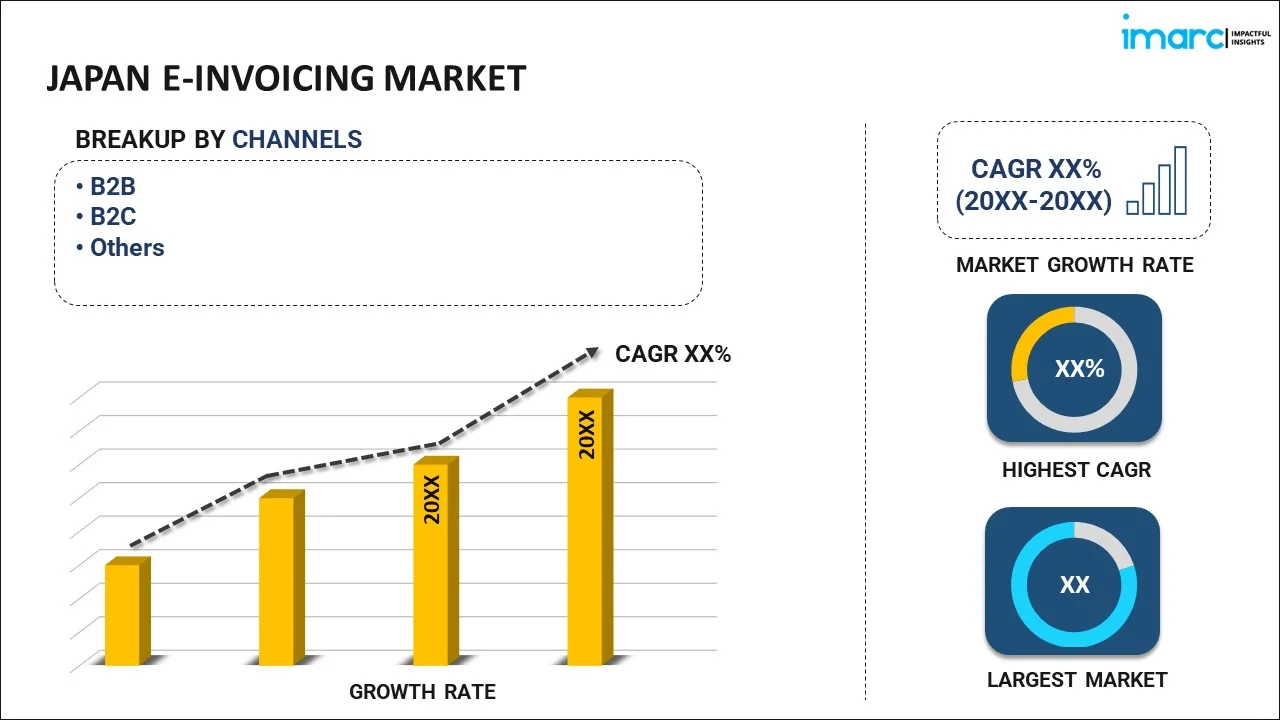
Japan E-Invoicing Market Report by Channel (B2B, B2C, and Others), Deployment Type (Cloud-based, On-premises), Application (Energy and Utilities, FMCG, E-Commerce, BFSI, Government, and Others), and Region 2025-2033
Market Overview:
The Japan E-invoicing market size reached USD 303.5 Million in 2024. Looking forward, IMARC Group expects the market to reach USD 1,700.0 Million by 2033, exhibiting a growth rate (CAGR) of 19.3% during 2025-2033.
|
Report Attribute
|
Key Statistics
|
|---|---|
|
Base Year
|
2024
|
|
Forecast Years
|
2025-2033
|
|
Historical Years
|
2019-2024
|
|
Market Size in 2024
|
USD 303.5 Million |
|
Market Forecast in 2033
|
USD 1,700.0 Million |
| Market Growth Rate (2025-2033) | 19.3% |
Electronic invoicing, also called e-invoicing, generates electronic bills during the goods and services exchange via digital platforms. Including debit and credit notes, purchase orders, and remittance vouchers, the system specifies the terms and conditions of the payment. E-invoicing can be conducted via smart devices, such as smartphones, laptops, computers, and tablets, while being integrated with the cloud and on-premises solutions. The e-invoicing system used in Japan works similar to a telephone network where the sender can be recognized immediately with a unique ID. As a result, it helps track business transactions and reduces system customization and maintenance costs while making valuable electronic documents safer.
Japan E-Invoicing Market Trends:
The market is primarily driven by the augmenting need for standardizing cross-border public procurement procedures, which complements the adoption of standardized electronic invoicing solutions. Also, the escalating preference for electronic alternatives replacing traditional invoicing methods across varied sectors, such as information technology (IT), banking, financial services and insurance (BFSI), energy, telecommunications, and retail, is acting as another significant growth-inducing factor. Furthermore, the rising need for interoperability between multiple document formats in administration processes, taxations, and regulatory body operations throughout the country is also boosting the growth of the e-invoicing market. Some of the other factors contributing to their uptake include rapid large-scale digitization, widespread adoption of industrial automation and the internet of things (IoT), and extensive research and development (R&D) activities.
Key Market Segmentation:
IMARC Group provides an analysis of the key trends in each segment of the Japan e-invoicing market report, along with forecasts at the country and regional levels from 2025-2033. Our report has categorized the market based on channel, deployment type and application.
Breakup by Channel:

- B2B
- B2C
- Others
Breakup by Deployment Type:
- Cloud-based
- On-premises
Breakup by Application:
- Energy and Utilities
- FMCG
- E-Commerce
- BFSI
- Government
- Others
Breakup by Region:
.webp)
- Kanto Region
- Kinki Region
- Central/ Chubu Region
- Kyushu-Okinawa Region
- Tohoku Region
- Chugoku Region
- Hokkaido Region
- Shikoku Region
Competitive Landscape:
The competitive landscape of the industry has also been examined along with the profiles of the key players.
Report Coverage:
| Report Features | Details |
|---|---|
| Base Year of the Analysis | 2024 |
| Historical Period | 2019-2024 |
| Forecast Period | 2025-2033 |
| Units | Million USD |
| Segment Coverage | Channel, Deployment Type, Application, Region |
| Region Covered | Kanto Region, Kinki Region, Central/ Chubu Region, Kyushu-Okinawa Region, Tohoku Region, Chugoku Region, Hokkaido Region, Shikoku Region |
| Customization Scope | 10% Free Customization |
| Post-Sale Analyst Support | 10-12 Weeks |
| Delivery Format | PDF and Excel through Email (We can also provide the editable version of the report in PPT/Word format on special request) |
Key Questions Answered in This Report:
- How has the Japan e-invoicing market performed so far and how will it perform in the coming years?
- What has been the impact of COVID-19 on the Japan e-invoicing market?
- What are the key regional markets?
- What is the breakup of the market based on the channel?
- What is the breakup of the market based on the deployment type?
- What is the breakup of the market based on the application?
- What are the various stages in the value chain of the industry?
- What are the key driving factors and challenges in the industry?
- What is the structure of the Japan e-invoicing market and who are the key players?
- What is the degree of competition in the industry?
Need more help?
- Speak to our experienced analysts for insights on the current market scenarios.
- Include additional segments and countries to customize the report as per your requirement.
- Gain an unparalleled competitive advantage in your domain by understanding how to utilize the report and positively impacting your operations and revenue.
- For further assistance, please connect with our analysts.
 Request Customization
Request Customization
 Speak to an Analyst
Speak to an Analyst
 Request Brochure
Request Brochure
 Inquire Before Buying
Inquire Before Buying




.webp)




.webp)












